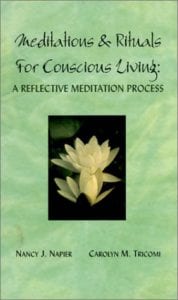Using Mindfulness for Recentering Meditation
Excerpts from “Getting Through the Day”
Followed by: Using Mindfulness for Recentering – a Meditative Exercise
When you are overwhelmed by the past, how can you reclaim your present-day awareness? This question comes up over and over again in the lives of abuse survivors. Being able to recenter yourself and handle life’s challenges effectively is an important element in determining the quality of your day-to-day experience. It also allows you to pace your healing so that you have times when you are free from the intensity and immediacy of past abuse experiences.
Whenever we become immersed in an inner child state and lose our current, adult perspective, we temporarily lose touch with our present environment and with a range of options for dealing effectively with life’s challenges. Take a moment to recall how, without your adult observer present, it’s easy to forget yourself. It’s no longer now, but then; it’s no longer here, but there. When it is then rather than now, you are more likely to draw on childhood coping strategies than on the more appropriate and effective choices available to your adult self. As we saw in the last chapter on triggers, it is extremely helpful to be able to return to your present-day awareness when a child state emerges spontaneously. The more you develop your adult observer, the more mastery you will experience as you deal with life in the present.
It is important to distinguish the observing part of your adult awareness from detached, cut-off parts that may arise from early experiences of abuse. For example, many adults who were hurt as children describe having an inner critic who constantly watches and comments on their every action. While this part may seem to be an observer, it is, in fact, usually a representation of some abuser from childhood. Another kind of seeming observer is described as a part that remains aloof from other people and finds fault with just about everyone. Again, this part represents wounds from childhood and actually operates to fend off closeness with other people. Your healthy adult observer doesn’t criticize you or cut you off from others. Instead, it recenters you.
This part of you represents a valuable and compassionate resource. From it emerges a point of view that acts to reassure you in ways you needed and deserved as a child – and would have internalized as you grew up if you had been treated with respect and care. All of the strategies that follow are based on a commitment to gentleness and a request that you explore what it is like to return to your present-day awareness as best you can whenever you realize you’ve gotten triggered into the past
How to Use this Meditation Exercise
Once a week or so, take a few moments to do the following imagery exercise and practice what it feels like to bring your awareness to what is moving through while imagining that you are planted on solid ground, not being swept away by your thoughts, feelings, physical sensations, or urges. When you practice this feeling of being grounded, then it’s more available to you in those moments when you really need it.
Mindfulness for Recentering – a Meditative Exercise
In your mind’s eye, imagine a stream or small river. It may be a stream you’ve seen before, or one that comes to mind as you open up your imagination to the process.
Notice that as you imagine the stream, you are standing or sitting comfortably on the bank of the stream – on solid ground. This is the place from which you can always notice the stream. Sense the ground under you. Notice that you can move closer to the stream or farther away, depending on how much water there is and how you feel about being close to the water . . . whatever feels safe to you.
Notice that as you imagine the stream, you are standing or sitting comfortably on the bank of the stream – on solid ground. This is the place from which you can always notice the stream. Sense the ground under you. Notice that you can move closer to the stream or farther away, depending on how much water there is and how you feel about being close to the water . . . whatever feels safe to you.
There are several things you can do when you notice what’s floating by on the surface of the stream:
you can simply watch the leaves float on by and then disappear .
you can reach out and take one and look at it more closely; .
you can simply gaze across the stream and look at the other side, knowing that leaves are flowing by but also knowing there’s nothing you have to do right now but just let them go on their way as your attention is focused elsewhere.
Whenever you begin to feel overwhelmed by the intensity or power of the flow of water in the stream or small river, by whatever you may be thinking, feeling, or wanting to do, imagine that you move farther up the bank of the stream. It is your choice to stay on solid ground, to do whatever needs to be done to keep yourself in the position of your present-day observer, noticing that there is no need to get swept away by the stream itself. Even if you feel as though you’ll get swept away, notice that you can continue to go farther up the bank of the stream until you feel safe enough to continue to observe what is flowing through your awareness.
